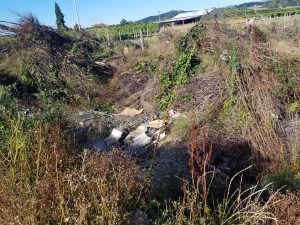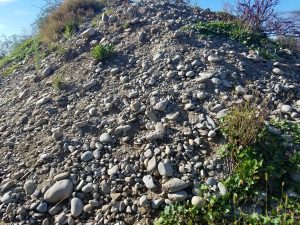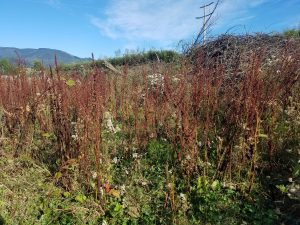When Lynda bought this property as a commercial kiwifruit orchard, there was lots that needed to change, and she is still in the process of getting where she wants to be. The first thing she had to do was rip out most of the kiwi vines (originally there was 800- now there’s approximately 100).
The next big step came from her disappointment that the land was completely flat, which led her to decide she would put a hill in! Wanting to incorporate some permaculture aspects into her growing, she wanted to use the hill as a powerful tool for irrigation. The idea is that she can plant herbs that need lots of sun and not too much water around the top of the hill, and herbs that need plenty of water and less sun around the bottom. This way, when it rains, the plants on top get some water but a lot of it will leech through quickly and puddle up around the bottom edge. Around the bottom will be things like parsley, basil, dill, cilantro, and chives as they’re much more water-intensive than other woody perennial herbs. Thyme, oregano, rosemary, and sage, are all examples of more drought-tolerant plants that will be good picks for the peak and slopes of the hill.
There was one section of the soil where she noticed a lot more rocks than any other section of the farm. This area would prove to be a perfect spot to dig up for the hill! Last year, she had a digger come in to make a big hole in the earth and pile up all of the stone-filled soil to make a mound. This season she hopes to have enough income to hire the digger to come back so that all of the removed kiwi trees that are currently just lying around can be filled into the pit. The digger will also have to make the hole a little bigger because it can’t possibly fit all of the deceased trees at the size it is now, which also means the hill will grow too. Once this is done, compost will be spread around the hill and she’ll be able to plant into it.
One project I’ve been working on is clearing the land adjacent to the hill. The plan for the field here is to implement a big native tree/shrub patch!
Right now, you can see lots of a weed called dock. This notorious plant has been known to take over farms in this region, and the plants are just about to seed! We’re just starting to focus our energies on removing as much as possible before it unleashes more of it’s wrath.

View from the peak of the mound (looking over prospective native tree patch)


